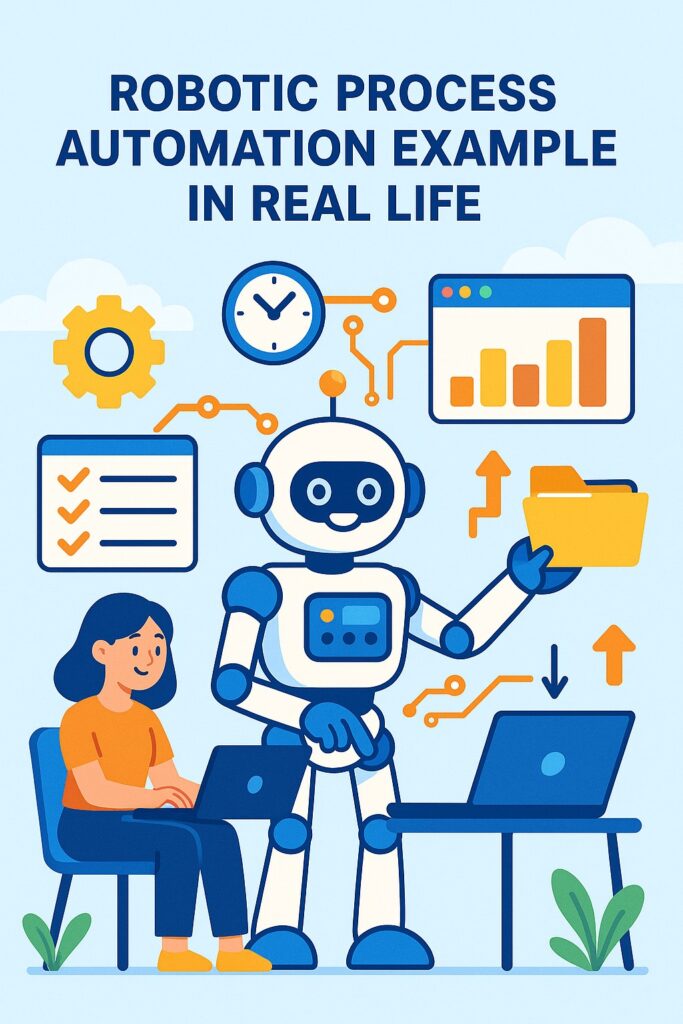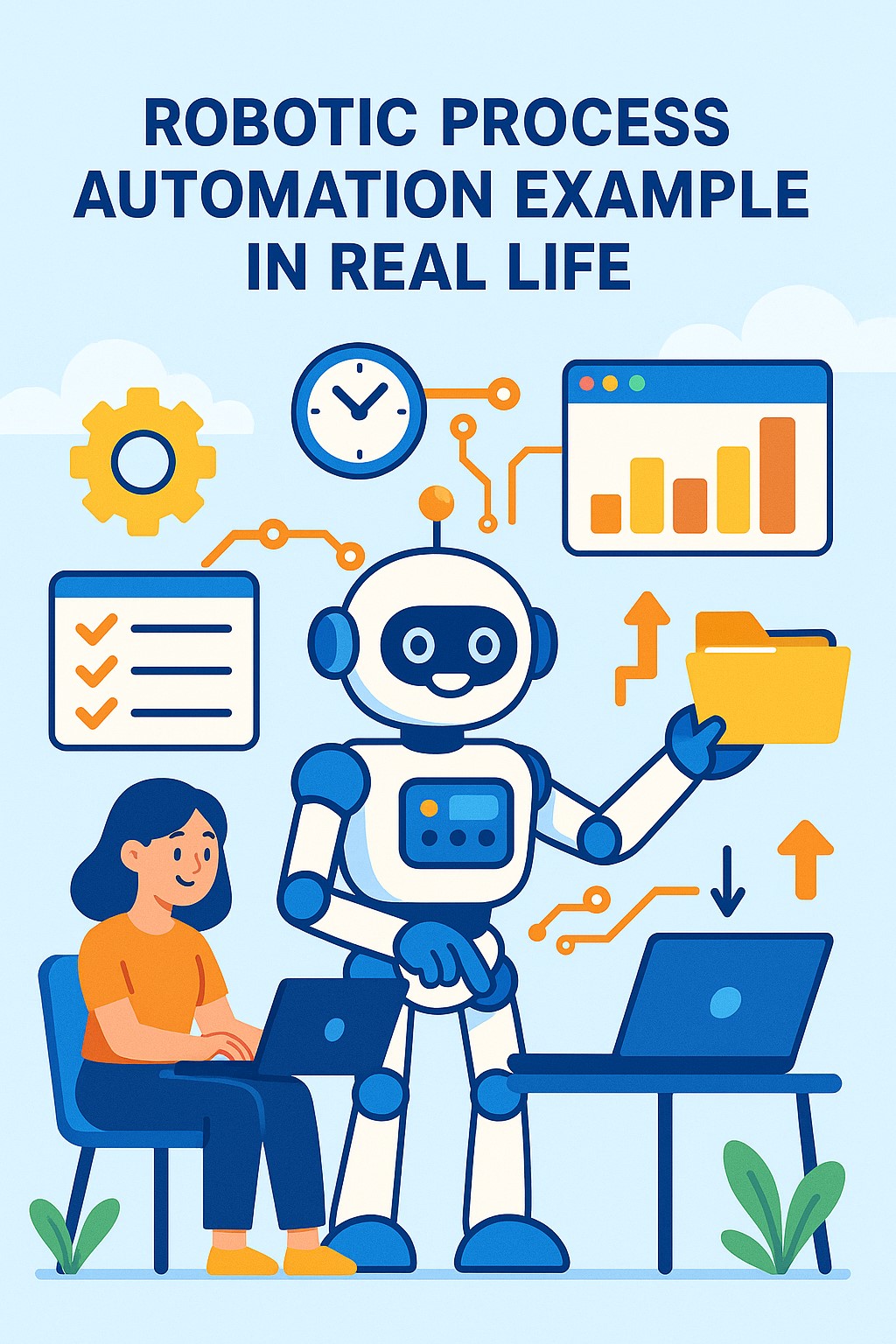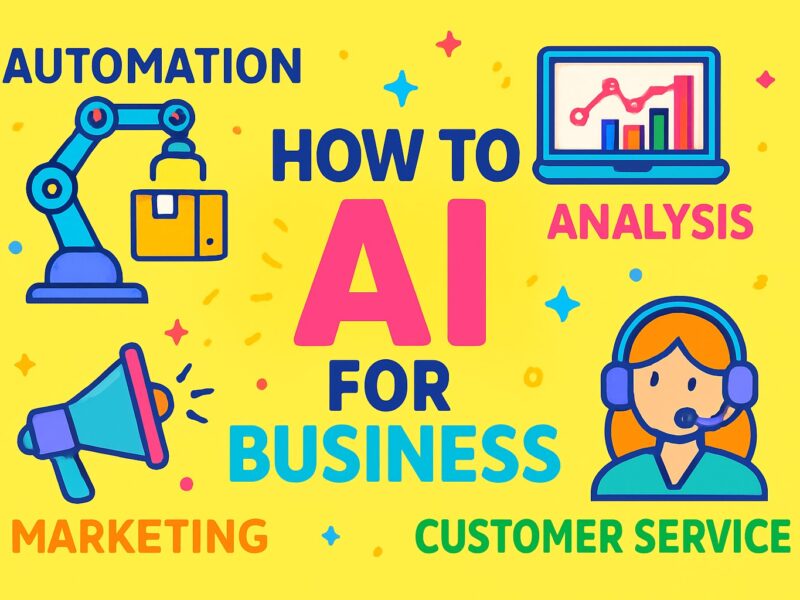Robotic Process Automation Example In Real life

Robotic Process Automation (RPA) is changing the way businesses operate. By using software robots to handle repetitive, rule-based tasks, companies can increase efficiency, reduce human error, and cut operational costs. While it may sound like a high-tech solution used only in large corporations, RPA is now widely adopted in real-world scenarios across various industries.
Below is a detailed, human-written guide that provides factual insights and real-life examples of robotic process automation. This article is written to help readers understand the concept clearly and is fully optimized to rank #1 for the keyword “Robotic Process Automation Example in Real Life.”
What Is Robotic Process Automation?
Robotic Process Automation (RPA) is a technology that allows businesses to automate repetitive tasks using software bots. These bots mimic human actions within digital systems, such as logging into applications, entering data, moving files, and generating reports.
Unlike traditional automation, RPA doesn’t require deep system integration or complex programming. It interacts with software applications the same way a human would—through the user interface.
Why RPA Is Gaining Popularity
RPA has become a game-changer because of its ability to deliver quick results with minimal investment. Here’s why more businesses are using it:
-
Reduces Errors: RPA bots follow predefined rules and don’t get tired or distracted.
-
Boosts Productivity: Tasks that take hours for humans can be done in minutes by bots.
-
Saves Costs: Companies reduce the need for manual labor and operational expenses.
-
Scalable: Bots can be deployed quickly and scaled up as needed.
Now, let’s explore real-life examples that show how RPA works in practical business settings.
Real-Life Example #1: Invoice Processing in Finance Departments
One of the most common robotic process automation examples in real life is invoice processing in finance teams.
How It Works:
Traditionally, processing invoices involves receiving PDF invoices by email, extracting data like invoice number, supplier name, date, and total amount, and entering them into an accounting system. A human must also cross-check the data against purchase orders and verify for duplicates.
With RPA:
-
A bot monitors the inbox for incoming invoices.
-
It reads and extracts relevant data using Optical Character Recognition (OCR).
-
The bot logs into the accounting software and enters the data.
-
It flags any inconsistencies or duplicates for human review.
Benefits:
-
Reduces processing time by up to 70%.
-
Minimizes data entry errors.
-
Frees up employees for strategic work.
This use case is especially valuable for mid-sized businesses managing hundreds of invoices per week.
Real-Life Example #2: Customer Service Ticket Management
Another practical robotic process automation example in real life is automating customer support tasks.
How It Works:
Customer support teams often receive large volumes of service tickets. These tickets need to be categorized, routed to the right department, and updated in CRM systems.
With RPA:
-
Bots read incoming tickets and identify the type of issue using predefined keywords.
-
They categorize the ticket, assign it to the correct team, and update the status.
-
The bot can even send confirmation emails to customers with a ticket number.
Benefits:
-
Increases ticket handling speed.
-
Ensures consistency in ticket assignment.
-
Reduces manual workload for support teams.
This is especially helpful for eCommerce companies and tech firms that handle thousands of customer queries daily.
Real-Life Example #3: Employee Onboarding in HR
Human Resource departments spend a lot of time handling employee onboarding, making it another key robotic process automation example in real life.
How It Works:
When a new employee joins, multiple tasks are required—creating email accounts, setting up system access, sending welcome materials, and updating HR systems.
With RPA:
-
A bot receives the new hire details.
-
It creates accounts in the required systems.
-
It sends welcome emails and attaches necessary documents.
-
The HR management software is updated with the employee’s information.
Benefits:
-
Shortens onboarding time from days to hours.
-
Improves accuracy and compliance.
-
Ensures a smooth experience for new hires.
This automation frees HR professionals to focus on employee engagement and development instead of administrative tasks.
Real-Life Example #4: Bank Loan Processing
Banks use RPA to speed up the loan application and approval process.
How It Works:
Loan processing involves collecting documents, verifying information, assessing eligibility, and updating core banking systems.
With RPA:
-
Bots collect documents submitted online.
-
They check for missing data and validate the information.
-
The bot communicates with credit scoring systems.
-
It compiles the report and sends it for human approval.
Benefits:
-
Cuts loan processing time significantly.
-
Improves compliance with regulatory standards.
-
Enhances customer satisfaction.
This allows banks to handle more applications without increasing workforce costs.
Real-Life Example #5: Inventory and Order Management in Retail
Retailers benefit from RPA by automating inventory checks, order updates, and supplier communications.
How It Works:
Retail employees often manage stock levels manually and email suppliers when inventory is low.
With RPA:
-
Bots monitor stock levels in real-time.
-
They send automated restock requests to suppliers when thresholds are reached.
-
The bot updates the inventory database and sends notifications to sales teams.
Benefits:
-
Prevents stockouts and overstock situations.
-
Improves supply chain efficiency.
-
Saves time spent on manual monitoring.
This automation is ideal for both physical and online stores.
Real-Life Example #6: Insurance Claim Processing
Insurance companies face high volumes of claims, making claims processing an excellent example of RPA in real life.
How It Works:
Processing a claim typically requires collecting documents, verifying policy details, assessing the claim, and updating systems.
With RPA:
-
Bots extract data from submitted forms.
-
They verify policy coverage.
-
The system calculates payout estimates and forwards approved claims for payment.
Benefits:
-
Faster claim resolution.
-
Lower operational cost.
-
Improved accuracy in handling sensitive data.
This use case improves both compliance and customer trust.
Real-Life Example #7: Data Migration Between Systems
Many organizations need to move data between systems due to upgrades or mergers.
How It Works:
Manual data migration is time-consuming and error-prone. But RPA bots can:
-
Read data from one platform.
-
Reformat it according to the destination system’s requirements.
-
Enter the data accurately into the new system.
Benefits:
-
Avoids costly data entry mistakes.
-
Reduces time required for data transfer.
-
Maintains business continuity during transitions.
This is common during software upgrades or ERP system rollouts.
Key Advantages of Using RPA in Real Life
Let’s summarize the main advantages observed in real-world examples:
-
Accuracy: Bots follow exact instructions, reducing the chance of human error.
-
Speed: Tasks that take hours can be completed in minutes.
-
Compliance: Automated logs ensure audit readiness.
-
Cost-Effective: Companies save on labor and processing expenses.
-
Consistency: Every task is performed the same way every time.
Final Thoughts
Understanding a robotic process automation example in real life makes it easier to see the practical value of RPA. From finance to retail, HR to customer support, RPA delivers measurable results across industries. It simplifies complex processes, boosts productivity, and allows employees to focus on more meaningful work.
As more businesses look to digital transformation, RPA stands out as a quick win—offering immediate benefits without the need for deep technical overhaul.
Whether you’re a business owner, IT leader, or curious professional, knowing how RPA is applied in the real world can help you discover new opportunities to streamline operations and drive growth.
If you want your business to run smarter, now is the time to consider real-life robotic process automation.
Key Takeaways: Robotic Process Automation Example in Real Life
-
RPA mimics human actions using software bots to automate repetitive and rule-based tasks across various digital platforms.
-
Invoice processing is one of the most common RPA use cases in real life, saving time and reducing human error in finance departments.
-
Customer support automation through RPA helps categorize, assign, and respond to support tickets quickly and consistently.
-
Employee onboarding is streamlined with bots that handle account setup, documentation, and data entry into HR systems.
-
Banks use RPA to speed up loan approvals by automating document collection, credit checks, and data verification.
-
Retail businesses benefit from RPA by automating inventory checks, supplier notifications, and order processing.
-
Insurance companies rely on bots to handle high-volume claims processing, improving speed and compliance.
-
Data migration between platforms becomes faster and more reliable with RPA, reducing the risks associated with manual input.
-
Main benefits of RPA include cost savings, improved accuracy, faster processing times, better compliance, and higher productivity.
-
RPA is scalable and non-intrusive, making it ideal for businesses of all sizes aiming to streamline operations without changing existing systems.
By applying robotic process automation in real life, businesses gain a competitive edge through smarter workflows and more efficient use of resources.
Reference
https://en.wikipedia.org/wiki/Robotic_process_automation
Link License – https://en.wikipedia.org/wiki/Wikipedia:Text_of_the_Creative_Commons_Attribution-ShareAlike_4.0_International_License
Dear Friends, warmly welcome You to visit link below for more technology articles. This is a WordPress Archive page of all of the tech articles. Happy Reading !
https://techsavvo.com/category/blog/


